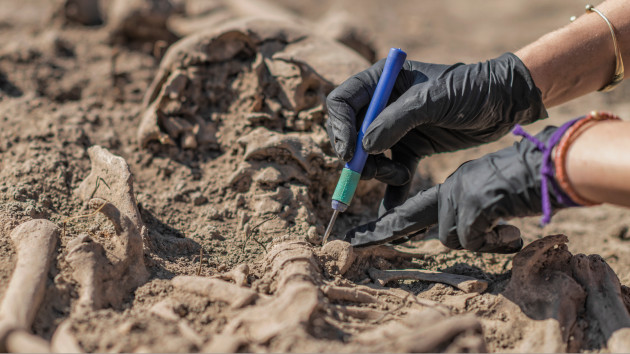(NEW YORK) — Scientists have discovered remarkable evidence that the first known successful limb amputation on a human occurred about 31,000 years ago, according to a new study.
A human skeleton dating to the Stone Age and found buried in the Liang Tebo limestone cave located in East Kalimantan, Borneo, shows that the left foot had been amputated and that the patient had recovered, according to a study published in Nature on Wednesday.
Archaeologists located the skeleton in 2020 after returning to the site where some of the earliest rock art was previously found, searching for archaeological deposits that may overlap with this early rock art, Tim Maloney, an archaeologist at Griffith University in Australia and lead author of the study, told reporters during a press briefing on Wednesday.
The researchers “slowly and meticulously” studied the skeleton, removing the sediments surrounding the burial as well as laser scanning and photographing, Maloney said. Once it was excavated, it was “quite clear” that the skeleton’s left foot was “entirely absent” and that an amputation occurred on the lower or distal third of their left leg, Maloney said.
A paleopathologist confirmed the skeleton presented a strong case for matching clinical instances of deliberate amputation, Maloney said.
The finding was significant because amputations require a comprehensive knowledge of human anatomy and surgical hygiene, as well as significant technical skill, the researchers said. In addition, most people who underwent amputation surgery died from blood loss and shock or subsequent infection before modern clinical developments such as antiseptics, according to the study.
The remains belonged to a young individual who survived the procedure and lived for another six to nine years, scientists said. In addition, the person who performed the amputation must have possessed detailed knowledge of limb structure, muscles and blood vessels to prevent fatal blood loss and infection, according to the study.
The researchers concluded that the amputation was unlikely caused by an animal attack or other accident, as these typically cause crushing fractures.
Maloney described the skeleton as “quite a remarkable pathological record of this individual and their burial” as well as ample insight into the community in Borneo during the Late Pleistocene period, defined as between 126,000 and 11,700 years ago.
It is also unlikely the amputation had been carried out as a form of punishment, because the individual seems to have received careful treatment after surgery and in burial, according to the study.
The findings suggest some early modern human foraging groups in Asia developed advanced medical knowledge and skills in the tropical rainforest environment in the Late Pleistocene period, which was connected to mainland Southeast Asia at the time that the individual who was found lived, Maloney said.
The skills may have been required as a result of rapid rates of wound infection in the tropics stimulated the development of novel pharmaceuticals such as antiseptics, which were harnessed from the medicinal properties of the rich plant biodiversity in Borneo.
“There’s a very strong case we make for understanding of the needs for antiseptic and antimicrobial management to enable the patient this individual to survive,” Maloney said.
Previously, the oldest known complex operation happened to a Neolithic farmer from France about 7,000 years ago, according to the study. The farmer’s left forearm had been surgically removed and then partially healed.
Copyright © 2022, ABC Audio. All rights reserved.












